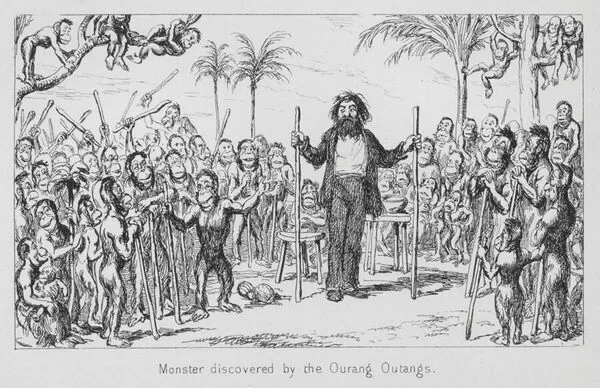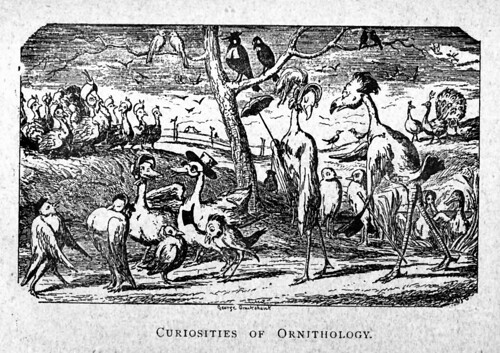By Spencer Williams

George Cruikshank’s illustration “Monster discovered by the Ourang Outangs” was created in 1861 and showcases a moment where the world is flipped on its head from how one would usually perceive the world and the word “monster.” This particular illustration is a plate engraving included in the book Holidays with Hobgoblins by Dudley Costello as a collaborative piece.
In this specific illustration you see a bunch of “Ourang Outangs” discovering a “monster.” This so-called monster is a representation of mankind as we see and know today. The “monster” in question is actually a human male and not the stereotypical “monster” we thought it would be. This is a moment of satire in George Cruikshank’s artwork. The irony that the monster is not a monster, but instead a man is meant to invoke curiosity, but also deceive expectations through humor. When you read the title it intentionally deceives you, only to show you that the world has been flipped on its head but also offer another perspective.
When you focus in on the Ourang Outangs you can see that they are all gathered in curiosity, holding sticks and watching the man to gain a better understanding of the “monster” they face. There seems to be a lead Ourang Outang who’s pointing or gesturing towards the man, and looking at the rest of the Ourang Outangs as if he’s trying to explain to them who or what the monster is and what the monster might be doing. This is a moment where the Ourang Outangs are showing human-like levels of intelligence and capability. This is a pivotal depiction of animals and their behaviors through a very different lens then what we are used to.
This particular plate comes from an era when Victorian Science was advancing and evolving. This would result in a change in viewpoints and mindsets. But what exactly was happening with Victorian Science? A well-known naturalist during the peak of change in the Victorian Era was Charles Darwin, arguably the most famous scientist of the 19th century, and certainly the most famous naturalist. He is credited for inventing the Theory of Evolution. Knowing what this means gives perspective to when Charles Darwin would release On the Origins of Species in 1859. Due to all of these new advances in science Victorians were navigating the changes of their outdated ways, to newer science that was more advanced than they previously had known. With these changes the artwork that would reflect that time frame would change in response as well.
The caricature “Monster discovered by the Ourang Outangs” came out a few years after Darwin released On the Origin of Species almost like a direct response to the theories and ideas that Charles Darwin shared in terms of shaking up Victorian ideas. There is another similar caricature that George Cruikshank created, in the same book by Dudley Costello called, “Curiosities of Ornithology.”

When you look at this particular plate you see birds with human-esqe qualities. These human-like qualities are presumed to be the “Curiosities” mentioned in the title of the piece. Keep in mind this too came out after Charles Darwin’s “Origin of the Species” was released. This is another moment of intense satire/irony where George Cruikshank takes into account the cultural atmosphere of the time surrounding Victorian Science and flips the world on its head. In this plate, you can clearly see the influence of Charles Darwin’s Theory of Evolution, in how George Cruikshank chose to anthropomorphize the Birds with human-like qualities, and attributes that you wouldn’t usually associate with birds.
This is another moment, much like in the previous plate with the Ourang Outangs, now with the birds where the world is flipped on its head. The things you are made to think or assume about the piece, turn out to be inaccurate and your perspective of the world in itself is changed. One can assume that, from the title of the piece, it would be about human studies or birds and their nature. But instead we are shown that the animals in this updated Victorian Era with new Science, are anything but the usual associations one would make when it comes to Birds or Ourang Outangs alike.
You can view these specific artworks here and also browse other artworks of George Cruikshank’s in UMBC’s Special Collections.


 Albin O. Kuhn Library & Gallery
Albin O. Kuhn Library & Gallery